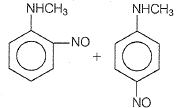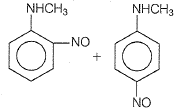Primary, secondary and tertiary nitroalkanes can be identifier by the action of:
1.
2.
3.
4. none of these
प्राथमिक, द्वितीयक और तृतीयक नाइट्रोऐल्केन को किसकी क्रिया द्वारा पहचाना जा सकता है?
1.
2.
3.
4. इनमें से कोई नहीं
An aromatic amine (A) was treated with alcoholic potash and another compound (Y) when a foul smelling gas was formed with formula C6H5NC. (Y) was formed by reacting a compound (Z) with Cl2 in the presence of slaked lime. Compound (Z) is:
1.
2.
3.
4.
एक ऐरोमैटिक ऐमीन (A) को एल्कोहॉलिक पोटाश और एक अन्य यौगिक (Y) के साथ उपचारित किया जाता है तब सूत्र C6H5NC के साथ एक बदबूदार गैस का निर्माण होता है। यौगिक (Z), बिना बुझे हुए चूने की उपस्थिति में Cl2 के साथ क्रिया द्वारा यौगिक (Y) का निर्माण करता है। यौगिक (Z) है:
1.
2.
3.
4.
This reaction is example of ?
1. Intermolecular C-N coupling
2. Intramolecular C-N coupling
3. Intermolecular N-N coupling
4. Intramolecular N-N coupling
यह अभिक्रिया किसका उदाहरण है?
1. अंतरा-अणुक C-N युग्मन
2. अंत: -अणुक C-N युग्मन
3. अंतरा-अणुक N-N युग्मन
4. अंत: -अणुक N-N युग्मन
Which of the following is more basic than aniline ?
1. Diphenylamine
2. Triphenylamine
3. p-nitroaniline
4. Benzylamine
एनिलीन की तुलना में निम्नलिखित में से कौन अधिक क्षारीय है?
1. डाइफेनिलऐमीन
2. ट्राइफेनिलऐमीन
3. p-नाइट्रोएनिलीन
4. बेन्जिलऐमीन
Name the end product in the following series of reactions,
CH3COOH ABC:
1. CH4
2. CH3OH
3. acetonitrile
4. ammonium acetate
अभिक्रियाओं की निम्नलिखित श्रेणी में अंतिम उत्पाद का नाम लिखिए,
CH3COOH ABC:
1. CH4
2. CH3OH
3. एसीटोनाइट्राइल
4. अमोनियम एसीटेट
Tertiary nitro compounds cannot show tautomerism because:
1. they are very stable
2. isomerises to give sec. nitro compounds
3. do not have labile H-atom
4. they are highly eactive
तृतीयक नाइट्रो यौगिक चलावयवता प्रदर्शित नहीं करते है क्योंकि:
1. वे बहुत स्थायी हैं
2. द्वितीयक नाइट्रो यौगिक देने के लिए समायवीकृत होते हैं
3. परिवर्ती H-परमाणु नहीं है
4. वे अत्यधिक सक्रिय हैं
Pyridine possesses :
(1) aromatic nature
(2) unsaturated aliphatic nature
(3) alicyclic nature
(4) aliphatic nature
पिरिडीन के पास होती है:
(1) ऐरोमैटिक प्रकृति
(2) असंतृप्त एलिफैटिक प्रकृति
(3) एलिसाइक्लिक प्रकृति
(4) एलीफैटिक प्रकृति
The correct order of increasing reactivity of C-X bond towards nucleophile in the following compound is
[2010]
1. I<II<IV<III
2. II<III<I<IV
3. IV<III<I<II
4. III<II<I<IV
निम्नलिखित यौगिक में नाभिकस्नेही के प्रति C-X आबंध की बढ़ती हुई सक्रियता का सही क्रम है:
[2010]
1. I<II<IV<III
2. II<III<I<IV
3. IV<III<I<II
4. III<II<I<IV
An organic compound X (mol. formula C6H5O2N) has 6 carbons in a ring system, three double bonds and also a nitro group as substituent X is:
(1) homocyclic but not aromatic
(2) aromatic but not homocyclic
(3) homocyclic and aromatic
(4) heterocyclic
एक कार्बनिक यौगिक X (अणुसूत्र C6H5O2N) के एक वलय निकाय में 6 कार्बन, तीन द्विबंध और प्रतिस्थापी के रूप में एक नाइट्रो समूह भी होता है, X है:
(1) समचक्रीय लेकिन ऐरोमैटिक नहीं
(2) ऐरोमैटिक लेकिन समचक्रीय नहीं
(3) समचक्रीय और ऐरोमैटिक
(4) विषमचक्रीय














